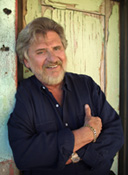 |
→ May 2007 Contents → Special Report
|
Special Report:
NAB 2007 May 2007
|
 |
|
The National Association of Broadcasters' annual show in Las Vegas is considered the largest electronic media show in the world. With over 108,000 attendees it is the ultimate toy factory. Everything from satellite dishes to an actual tank from Iraq was on display.
From the standpoint of photojournalists, whose profession is increasingly crossing over into the realm previously only occupied by the broadcast industry, it is a look into the future of our acquisition tools.
PF Bentley and I trudged for miles through the four huge convention halls. PF's report on what he saw is in this section of The Digital Journalist. As he says, the show is simply WOW!
The show kicked off with Apple's look at the new Final Cut Studio 2. PF reports on it.

The NAB panel on the future of the Internet. From left: Miles O'Brien of CNN, Terry Heaton, Zadi Diaz, Elizabeth Osder, Michael Rosenblum and Amanda Congdon.
"This is the end of the old world," added Rosenblum. "The arrival of cheap cameras and easy-to-use editing systems has taken away the exclusive hold TV stations once had on producing high-quality video." He pointed to media blogger Jeff Jarvis in the audience who was shooting with a small video camera, and said traditional TV networks would be better off by hiring hundreds of video bloggers like Jarvis instead of paying anchors like Katie Couric "millions of dollars to read the news for 13 minutes a night."
Rosenblum painted a bleak picture for broadcasting, comparing it to Kodak's struggle to transform its film-based business strategy to the world of digital imaging. "They are going out of business," he said of broadcasters who don't adapt. By contrast, he said, newspapers have been threatened by the Web for long enough, so they are beginning to figure out how to react to a "platform-agnostic" world.
Heaton said local stations need to find a way to partner with "the local Web." He pointed to news aggregator sites like Yahoo! News and Google News. "They have changed viewers' expatiations of conventional TV news – especially the 'film at 11' tradition of news teases," he said. "People don't want to be teased; they can go to the Web and get what they want."
Heaton pointed to one local blogger in Nashville who's taken an obsessive interest in his local county government. "He's so far beyond what any newspaper is doing," he said, urging newsrooms to consider hiring more people with local roots, rather than reporters constantly moving to ever-larger markets.
A LOOK AT THE NEW CAMERAS
The buzzword is TAPELESS. Virtually every manufacturer is positioning itself for a tapeless world.

Under glass, a look at the forthcoming Sony XD CAM.

Canon's small-sized HV 20 camcorder

The tiny Panasonic AVCHD, developed in partnership with Sony.

JVC's new GYHD250U
Each year we include an outrageous item, in case you come into an unexpected inheritance. Our pick from this show is RF Central's turbine-engined mini helicopter. It will carry a 40-pound payload, so you can put any cameras you want on it. It has an HD transmitter, which will send the signal from the camera for up to two miles. It can hit 100 mph. It is perfect for covering sports events (or wars). However, you need to either be a certified pilot or hire one. It is not a toy. You can snap one up for a mere $80,000.

Pilot Garry Travis poses with the RF CENTRAL helicopter.
Please read P.F. Bentley's report on more goodies from NAB.
© Dirck Halstead
Editor and Publisher of The Digital Journalist
|
|
Back to May 2007 Contents
|
|